Unsure about your French table manners? Click Here to download > > How to avoid these 10 food etiquette mistakes !
- Home ›
- Destinations ›
- Normandy ›
- Giverny Day Trip
How To Organize The Best Giverny Day Trip From Paris
Updated 12 June 2025 by Leyla Alyanak — Parisian by birth, Lyonnaise by adoption, historian by passion
There are several ways to take a Giverny day trip from Paris: you can drive, you can use public transport, or you can take a day tour. I've done all three so here are the pros and the cons of each, including some recommendations.
There are places where art and life merge so well that telling one from the other is difficult.
Giverny is one of these.
And because it's only open seven months a year (April through October), it is hugely popular and demand for visits is high.
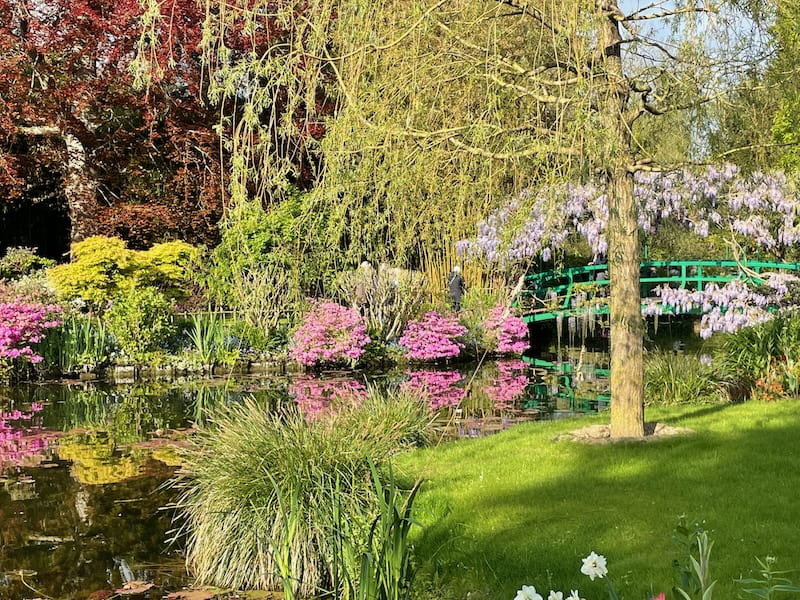
Tucked away in the Normandy countryside, this quiet village was Claude Monet’s home for over four decades — and the living laboratory for his most famous works.
Not only can you visit his house and garden, but you'll step right into his world, where water is a backdrop for his more than 250 paintings of water lilies and the colors look so bright they can't be real.
I recently made three visits here - on a tour, by public transport, and by car, and each had its strong (and less strong) points. Let's have a look.
NOTE: Pages on this site may contain affiliate links, which support this site. See full Privacy Policy here.
How to get to Giverny from Paris by train, tour or car
Giverny may technically be in Normandy, but it's not far from Paris and easily managed in a day. It all depends on how you want to spend your precious hours. Here's how to get to Monet garden from Paris:
Taking a day tour to Giverny
This is without a doubt the easiest way to visit Giverny from Paris: join a tour in Paris, magically end up in Giverny, visit, and be whisked back to Paris.
Since most group tours are similar to one another, I suggest you choose one from a reputable company which covers the essentials: safe and comfortable transport back and forth, skip the line, and a knowledgeable guide who can share a bit of the backstory with you.
Most highly recommended day tours to Giverny from Paris
- Small group half-day tour: Transport with a van for a small group, and includes a stop at Monet's
- Monet's House & Garden plus Giverny Village: This is a private tour with good guides to go in comfort
- Giverny bike tour and picnic: Bus tour to the gardens, and then bike to the village of Giverny and time for a picnic (which you'll buy at a local market)
Pros: I’d rather spend my day viewing art and beauty than searching for the right train track. Schedules are tight and you’ll be fighting everyone for your place in line once you arrive. Leaving it all to someone else means you can focus on the venue rather than getting there.
Cons: You'll get there when everyone else does, and it can get crowded. It's also a bit more expensive than organizing things on your own.
Taking the train to Giverny from Paris
The train from Paris to Giverny is a relatively straightforward option but is best if you're accustomed to using Paris transport independently.
Take the metro in Paris to St Lazare station: when you arrive, you'll be looking for the train to a station called Vernon (NOT Giverny!) You can buy your train ticket ahead of time or on the spot - just leave enough time to get to your train because St Lazare can be confusing. I try to get there an hour ahead of time, but that's me...
Once you reach Vernon, take the bus right outside the train station (not the little tourist train, which costs more and takes longer) and buy a round-trip ticket - cash only, no cards. Beware the schedules*, and ask the driver to confirm return trips. It should take about 15 minutes to get to Giverny from Vernon. Another option, if you're up to it, is to walk the hour or so it will take you from the train station (follow the pedestrian and bike signs).
Hop off the bus at destination and follow the signs. You can buy your tickets to Monet's at the entrance, but if I were you, I'd get it ahead of time directly from the Fondation Claude Monet, the foundation that runs the house and gardens to avoid standing in line when it's crowded.
*Just bear in mind that if a bus is full, you'll have to wait for the next one, and if you have a train to catch, that could be a little tricky. I tend to make sure there are at least two buses between myself and my train, especially towards the end of the day.
Pros: You can time your visit to avoid the worst of the crowds by arriving early or late in the day.
Cons: It can be mildly complicated to navigate the Paris metro and St Lazare station if you've never done this before. Also, you have to be time-conscious and make sure you get back on time for your Giverny to Paris train.
Driving to Giverny
By car to Giverny should take you about an hour-and-a-half. It took me quite a bit longer but that was on purpose, because I didn't want to take the highway and always prefer the smaller country roads.
Head for highway A13 (towards Rouen) until you reach exit 14 (Bonnières) or exit 16 (Douains). Remember, this is a toll road and some ways down you'll have to pay.
Once off the exit, follow the signs to Vernon, and then to Giverny.
Alternatively, you can get off the highway before the toll segment: take exit 13 to Mantes Ouest and follow the D113 after that. Here's the Google map.
Once you get to Monet's house, there's plenty of parking, some of it free, or otherwise not expensive. If you arrive before the tour buses, you can park in one of the parking lots nearest Monet's house but that said, everything is close by.
Pros: You can come and go as you please and enjoy the freedom of getting there first or leaving last.
Cons: You have to drive...
I don't always drive my own car around France. When I rent, I use Discovercars, which searches the web for the best deals from ALL car rental agencies.
Impressionism: A snapshot
It's all very well to want to surround ourselves with beauty, but what exactly is Impressionism? Here's a quick reminder.
Before Claude Monet, art followed classical rules — realistic, polished and true to life.
Impressionism changed everything.
It embraced light, color, and the fleeting moments of everyday life — even the imperfect and mundane. Monet painted quickly, with bold brushstrokes and vivid tones, all of which were considered sloppy or unfinished by the standards of his day.
Like many Impressionists, he worked outdoors, returning to the same scenes again and again, at different hours, and in changing seasons, trying to pin down an elusive mood or atmosphere.
His house and gardens at Giverny, where he lived for more than 40 years, reflect this obsession. The gardens were no accident: he designed them as living compositions, which he then captured on canvas.
Water Lilies, anyone?
 From simple paintings to the monumental panels displayed at L'Orangerie in Paris, Monet painted some 250 different "water lilies" ©OffbeatFrance/Leyla Alyanak
From simple paintings to the monumental panels displayed at L'Orangerie in Paris, Monet painted some 250 different "water lilies" ©OffbeatFrance/Leyla AlyanakVisiting Monet's house in Giverny
Monet’s house is relatively large, although not by today’s standards, considering his household.
He was father of two sons from his first wife, Camille, but after her death, he married his second wife, Alice, who had six children of her own. His private life was anything but tranquil.
He first met Alice when she was the wife of Ernest Hoschedé, a wealthy patron of his (he was the first owner of Impression, Sunrise, the painting after which Impressionism was named) and they all ended up living under the same roof while Camille was still alive.
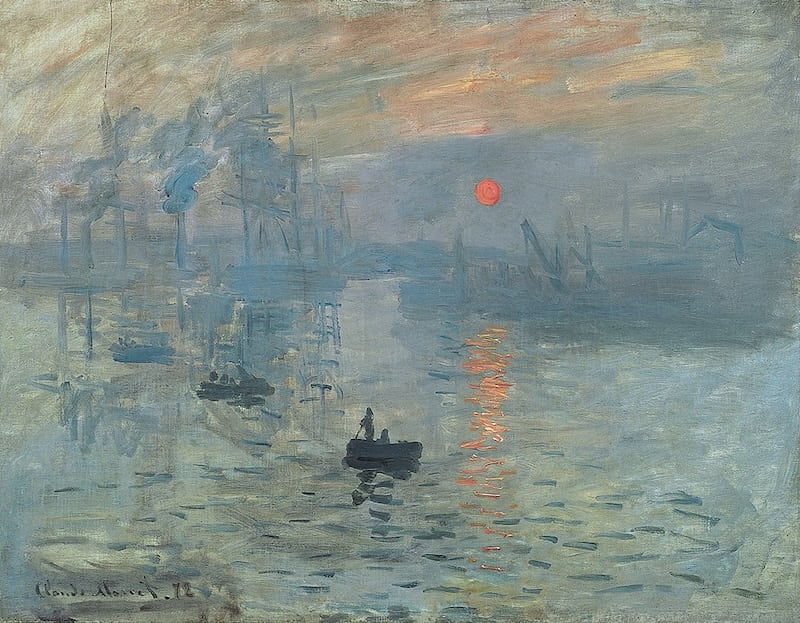 “Impression, Sunrise” by Claude Monet (1872) — This misty view of Le Havre’s harbor wasn’t meant to start a movement, but it did. When Monet exhibited it in 1874, a critic mocked the work’s loose, unfinished style as “just an impression.” That insult gave rise to Impressionism, a movement that forever changed how we see light, color, and the world.
“Impression, Sunrise” by Claude Monet (1872) — This misty view of Le Havre’s harbor wasn’t meant to start a movement, but it did. When Monet exhibited it in 1874, a critic mocked the work’s loose, unfinished style as “just an impression.” That insult gave rise to Impressionism, a movement that forever changed how we see light, color, and the world.Monet and Alice, who was then still married to Hoschedé, would end up together – relationships in artistic circles were unsurprisingly liberal – after Camille's death, and plenty of people believe Alice's youngest son was Monet's.
During the day, Monet would paint, often from dawn to dusk, chasing the ever elusive light and shadows of his garden. In the evenings, the house would welcome fellow impressionist painters, along with writers and intellectuals. They would exchange ideas over long dinners flowing with conversations about art and beauty.
WHAT SHOULD I SEE FIRST?
Once you arrive, where should you go first: Mone'ts house, the Clos Normand or the Water Garden? Good question!
I would opt for the Water Garden: it's extremely popular and taking photographs that are free of people is a challenge once the tour buses arrive. I would then head for the house: I don't mind waiting in line and snaking up the stairs... the rooms are small but as the line moves forward, you'll be able to take a few shots with no one in them. The Clos Normand can be your reward at the end.
The Water Garden
You can reach the Water Garden, which reflects Monet’s fascination with Japanese art, through a small tunnel under a road and a flight of stairs at the bottom of the Clos Normand.
Twice a day, as though rocked by a gentle wind, pond cleaners wield their nets, clearing away any debris that had the temerity to stray.
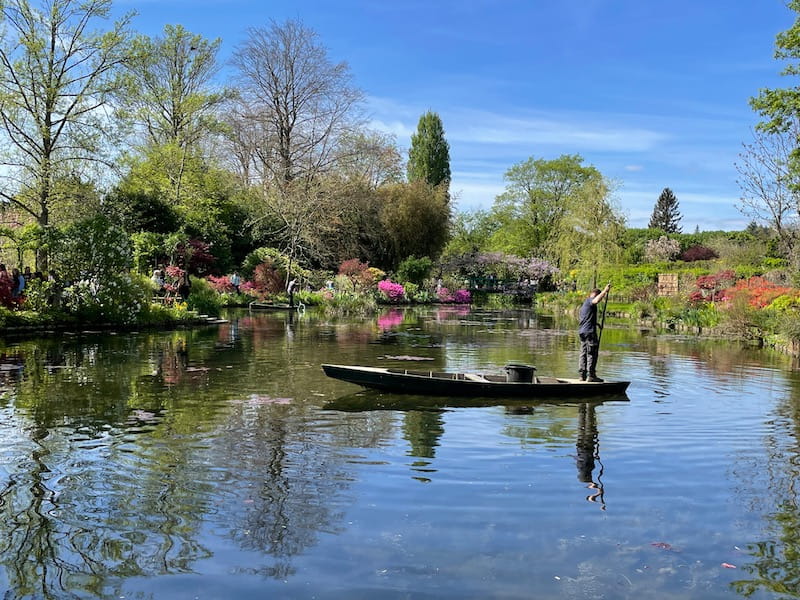 Cleaning the pond is a twice a day task at Giverny ©OffbeatFrance/Leyla Alyanak
Cleaning the pond is a twice a day task at Giverny ©OffbeatFrance/Leyla Alyanak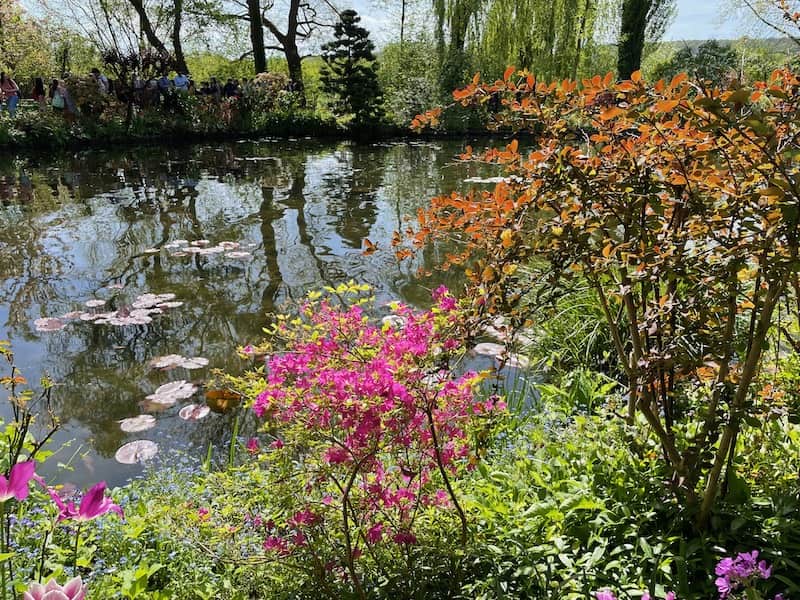 Spring is wonderful for flowers, but not the best season for water lilies... yet even so, they're stunning. These water lilies inspired some 250 paintings in the "Nymphéas", or Water Lilies series. Typical Monet, seeking to capture the interplay of light, water, and atmosphere under various conditions at different times of day. ©OffbeatFrance/Leyla Alyanak
Spring is wonderful for flowers, but not the best season for water lilies... yet even so, they're stunning. These water lilies inspired some 250 paintings in the "Nymphéas", or Water Lilies series. Typical Monet, seeking to capture the interplay of light, water, and atmosphere under various conditions at different times of day. ©OffbeatFrance/Leyla AlyanakWhile it’s easy to imagine how Monet would have found the atmosphere contemplative, idyllic even, reality is a bit different, more one of crowds jostling to capture their best Instagram selfie.
But back then, there were no crowds and these gardens were a perpetual source of inspiration. Monet created his surroundings just as he would a painting and by choosing the flowers as he did, he would guarantee to have something to paint, whatever the season.
This was his garden, his muse and canvas, his outdoor atelier, the genesis of the works you would someday be able to see at the Orangerie and the Musee d'Orsay.
Monet's house
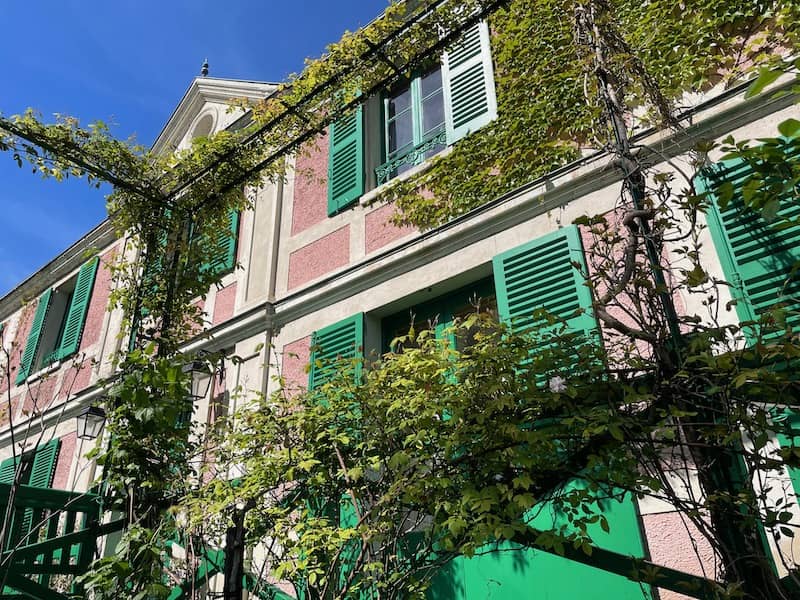
Monet was quite the character. He even managed to get the River Epte – which once ran through his property – diverted so he could build his pond.
We can glean a lot about his daily life by visiting the house in which he lived from 1883 until his death in 1926. It is remarkably preserved, and inside, you’ll find replicas of his artworks, along with his personal collection of Japanese prints. The rooms may reflect the period's typical rural Normandy style, but definitely mixed with a dash of the artist’s genius.
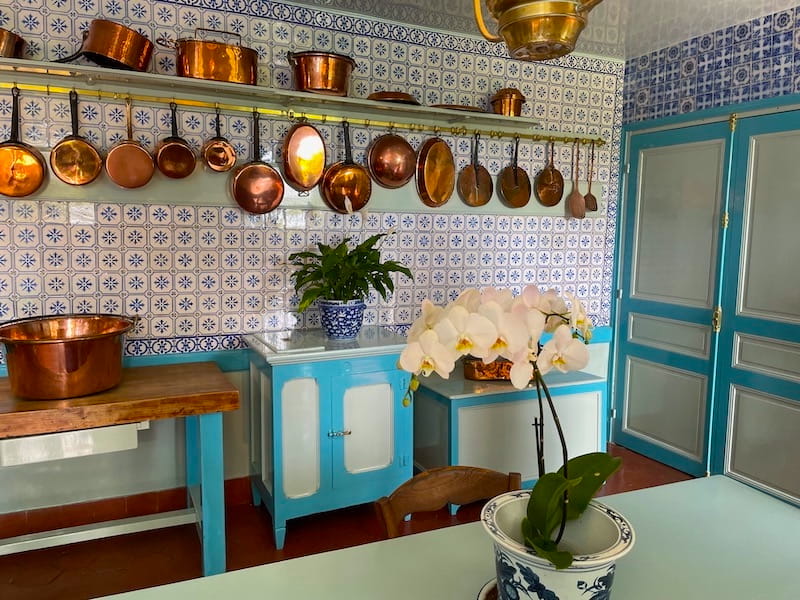
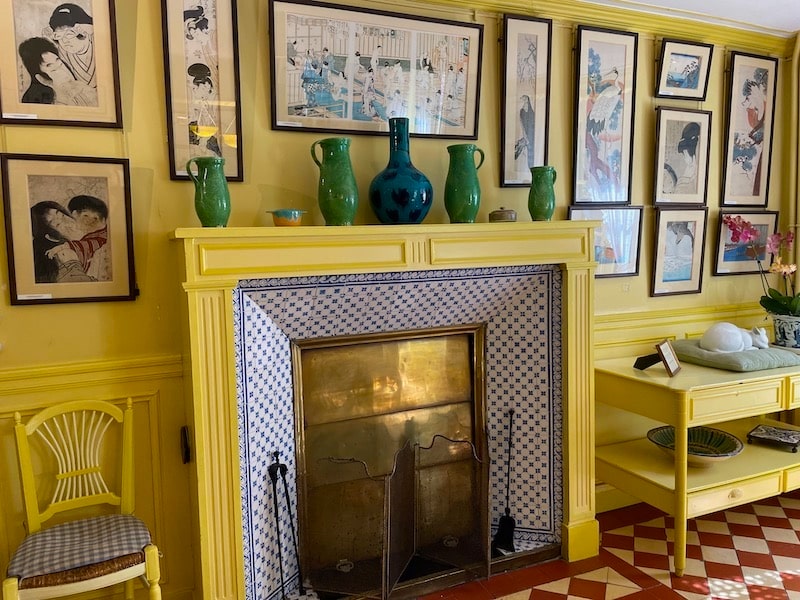
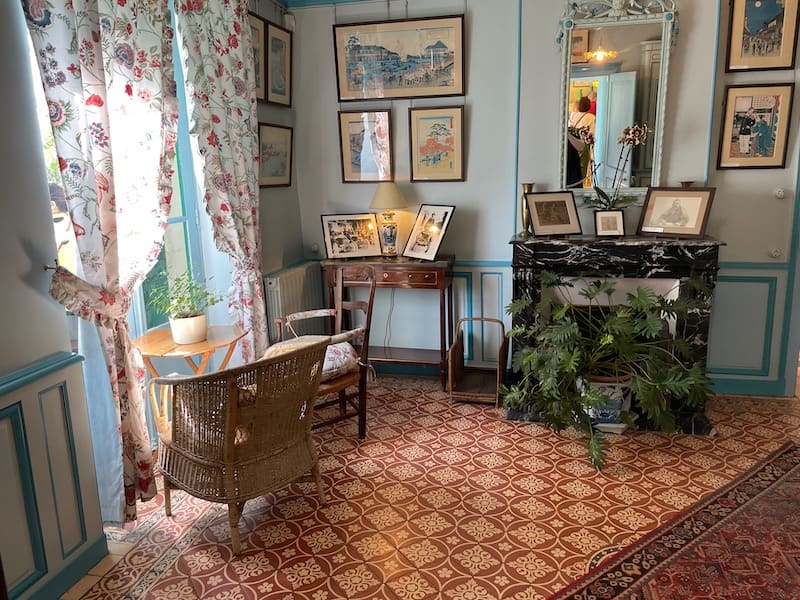 Monet's house, reflecting his love of light and color ©OffbeatFrance/Leyla Alyanak
Monet's house, reflecting his love of light and color ©OffbeatFrance/Leyla AlyanakTo visit the house, you (usually) have to stand in line and follow it as it snakes through the atelier, up the stairs, across and down again, exiting near the gift shop where you can pick up a trinket or a book.
The Clos Normand
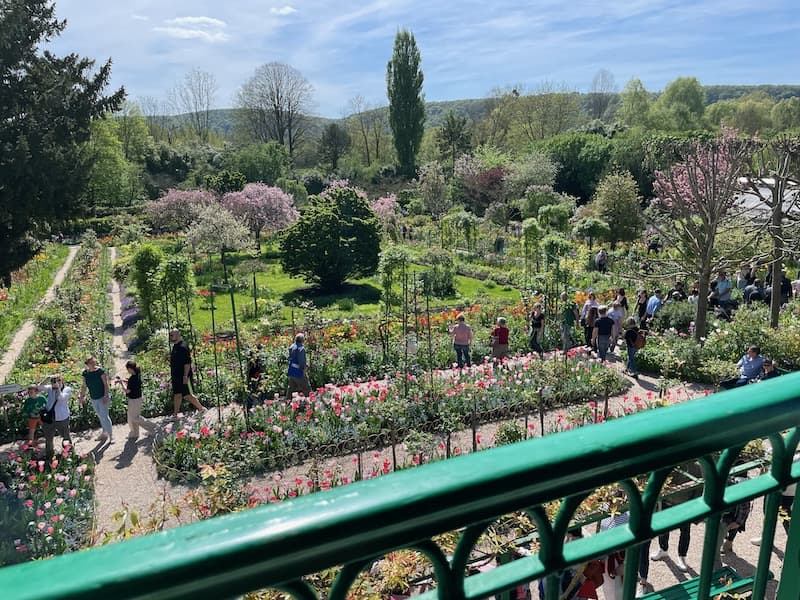 View of the Clos Normand from the first floor of Monet's house ©OffbeatFrance/Leyla Alyanak
View of the Clos Normand from the first floor of Monet's house ©OffbeatFrance/Leyla AlyanakThe Clos Normand is the part of the garden directly in front of Monet's house, his first sight of the day. You'll have to cross it to get to the house, but you can explore it at your leisure either before or after.
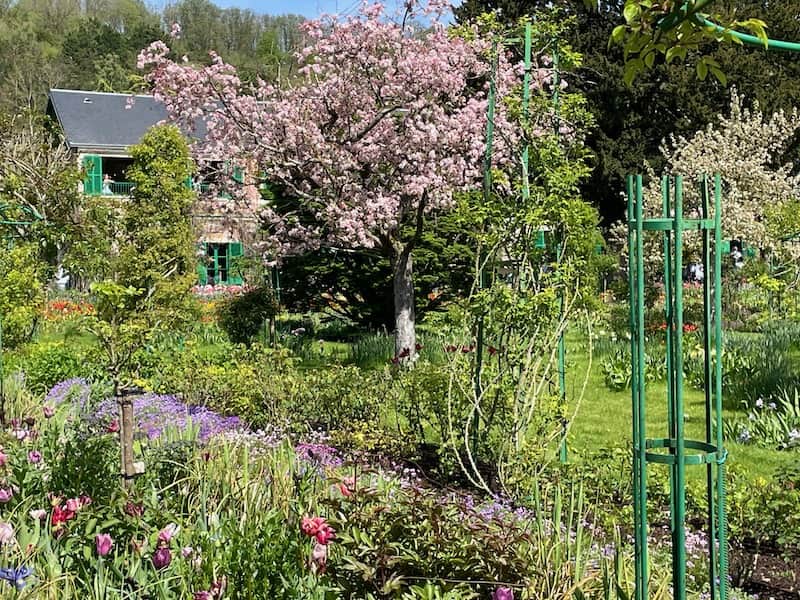 The Clos Normand, in front of Monet's house ©OffbeatFrance/Leyla Alyanak
The Clos Normand, in front of Monet's house ©OffbeatFrance/Leyla AlyanakThe garden is filled with flowerbeds of tulips, irises, peonies, roses, some for spring, some for autumn, and crisscrossed by central alleys covered in climbing plants. When it comes to color, nature here seems to have been let loose, a bit like in his paintings.
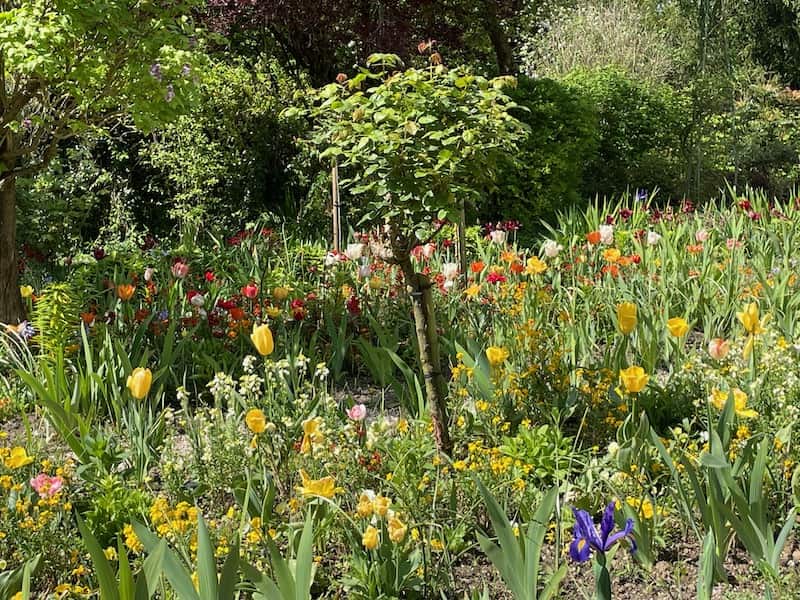 Flowerbeds cover the ground of the Clos Normand garden ©OffbeatFrance/Leyla Alyanak
Flowerbeds cover the ground of the Clos Normand garden ©OffbeatFrance/Leyla AlyanakThings you might NOT know about Monet's House
Beyond the pastels and water lilies, this was a living, breathing home with plenty of quirks and particularities. Here are a few:
Monet may have painted his groceries before eating them
This rumor has long circulated and I haven't been able to verify it, although I love the idea! It goes something like this: Monet was known to ask his cook to hold off on preparing the vegetables — especially artichokes, asparagus or cabbages — so he could paint them first, as obsessed with the color and texture of food as he was with flowers, a bit like today's social media mavens photograph a meal before daring to dive into it.
Well, it sounds plausible but in the absence of evidence, let's just call it legend and enjoy it!
Monet’s Japanese prints weren’t just décor
The house is filled with over 200 Japanese ukiyo-e prints by artists like Hokusai and Hiroshige. Monet didn’t just collect them, he studied their compositions, perspectives and how they treated nature. You can see how they deeply influenced the layout of his Japanese-style water garden.
His kitchen was one of the most modern in the region
For a rural home in the late 19th century, Monet’s blue-and-white tiled kitchen, outfitted with copper cookware, was unusually sophisticated. He entertained frequently and insisted on excellent food. His daily menus were noted in ledgers, many of which survive.
He micromanaged the garden with military precision
Monet wasn’t a passive admirer of nature. He designed the Giverny gardens like a living canvas, down to the flowering schedules. Gardeners weren’t allowed to plant anything without his approval, and he even had flowerbeds replanted mid-season if the colors clashed.
A few additional tips
Nothing is perfect, but awareness is half the battle.
- You’ll find crowds. There's no getting around this. But some periods are even more crowded than others, like the school holidays. For a better experience, check holiday schedules and try to avoid visiting at the same time as half of France’s schoolchildren.
- If you're on your own, you might avoid some of the crowds by arriving right at opening time, visiting during lunch, or after 4pm when the tour buses have gone. But, no guarantees.
- My personal take on Giverny: entries should be timed, and the number of visitors limited. The property is too small to accommodate everyone (at present, 1700 daily visitors on average). Plenty of major sites in France have a scheduling system, which just requires a bit of planning, and provides greater enjoyment for all.
Was Giverny worth it? Absolutely! One day I visited the Orsay in the morning for a beauty-filled day of Impressionism and while it's definitely a race, both CAN be done in a day.
5 Things to do in Giverny after (or before) the Monet gardens
Giverny may be best known for Monet’s house and gardens, but the village and its surroundings have plenty more to see, if you have a few hours to spare.
1. Giverny Museum of Impressionisms
Just a short walk from Monet’s house, the modern Musée des Impressionnismes explores not just Monet but also his contemporaries and followers with temporary exhibitions and a calm, serene garden away from the crowds (and which looks nothing like Monet's!)
2. Stroll the village of Giverny
It’s a tiny village (you can see it all in under 20 minutes) but it's picture-perfect. The streets are lined with charming stone houses, hollyhocks, ivy, and flowering vines. It’s worth wandering just to absorb the atmosphere, especially early or late in the day when the crowds thin out.
3. Visit the church and Monet’s grave
At the far end of the village, about 10 minutes from Monet's house, is the Église Sainte-Radegonde, a modest Romanesque church (with later Gothic additions). In the adjacent cemetery, you'll find Claude Monet’s grave, marked by a simple family tomb surrounded by flowers.
4. Rent a bike and ride along the Seine
From Giverny, you can cycle along quiet country roads and riverside paths toward the Seine Valley — limestone cliffs, poplar trees, and of course, Impressionist light. Vernon is an easy and scenic 4 km/2.5 mi ride, even for beginner cyclists.
5. Visit nearby Vernon
There's plenty to see and do in Vernon, which is where the Paris to Giverny train stops.
- Take a stroll in the town's historic center, with its cobbled streets, half-timbered houses, and a handful of charming squares and cafés
- Walk or ride along the riverside promenade, a great place for a picnic (and a good starting point if you want to cycle to Giverny)
- Across the bridge from Vernon is the Old Mill on the Seine, one of the town's most photographed spots, a half-timbered medieval mill precariously (or so it seems) perched over the river
- The Collegiate Church of Notre-Dame is a mix of Romanesque and Gothic architecture known for its rose window. Monet painted it several times, much like his Rouen Cathedral series
- The Musée Blanche Hoschedé-Monet (Monet’s stepdaughter), with a small collection of Impressionist paintings and two paintings by Monet himself
Before you go…
To better understand Monet’s work around light and seasons, explore his series of 30 paintings of the western façade of Rouen Cathedral, several of which are in the Orsay Museum.
Or if you’d rather push further, the train to Vernon continues to Rouen, where you’ll find plenty of impressionist paintings – it's called the capital of Impressionism for a reason.
And if you cannot take a full day and must sadly give Giverny a miss, at least book a skip-the-line-ticket to the Orsay Museum and spend a couple of hours on this fabulously guided tour of its highlights.
Did you enjoy this article? I'd love if you shared it!


